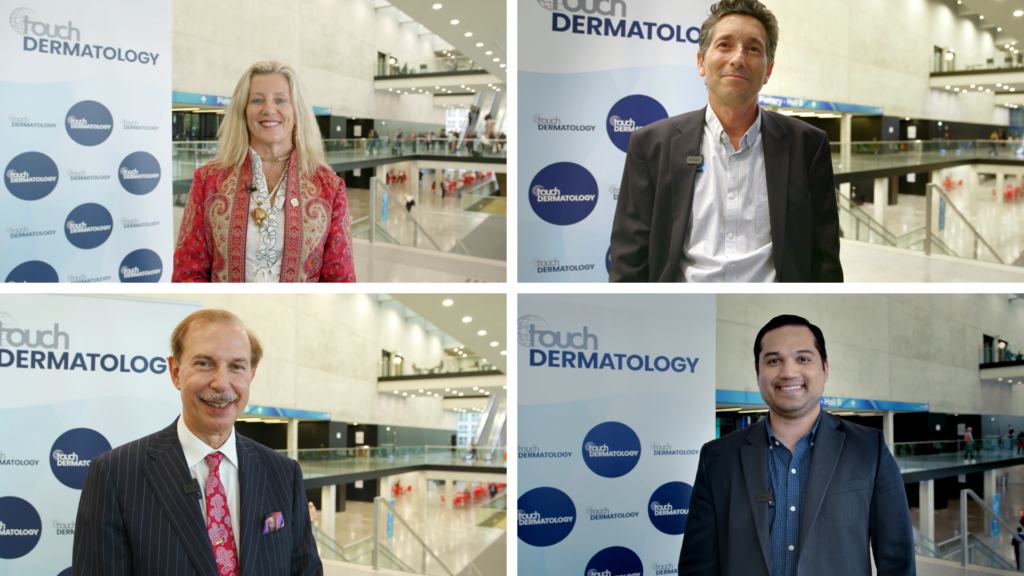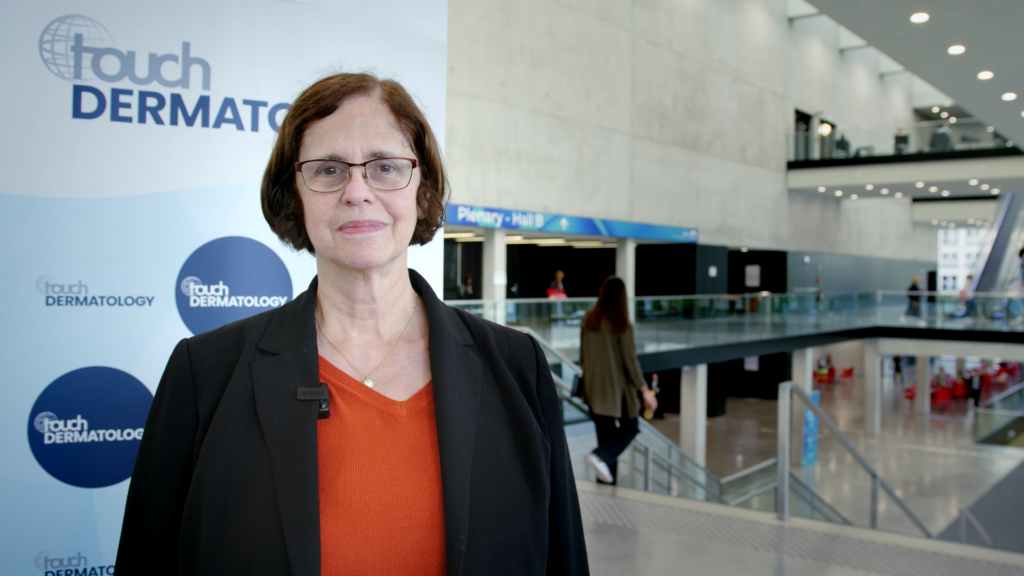touchDERMATOLOGY coverage from EADV 2024:
Cutaneous lichen planus is a T-cell mediated autoimmune inflammatory skin disorder that currently has no FDA-approved treatments. The condition typically appears as itchy, polygonal, purple and pruritic papules on areas such as the wrists, elbows, and shins. While some cases are short-lived and resolve on their own, many patients experience chronic, recurring symptoms that significantly impact their quality of life. With limited effective treatments and the sometimes chronic nature of the disease, new therapies are much sought after.
In this conversation, we speak with Dr. Aaron Mangold (Mayo Clinic in Arizona, Scottsdale, AZ, USA), the lead investigator of a recent phase 2 clinical trial (NCT05593432) investigating the efficacy and safety of 1.5% ruxolitinib (RUX) cream for cutaneous lichen planus. We discuss the rationale for investigating the topical JAK1/JAK2 inhibitor, RUX, in this patient population, the specifics of the trial, and importantly, the promising findings in terms of both lesion clearance and symptom relief. We also explore the safety profile of topical RUX cream and discuss the potential implications of these results for the future management of lichen planus.
Associated abstract: Mangold A et al. Efficacy and safety of ruxolitinib cream in patients with cutaneous lichen planus: Results from a phase 2, randomized, vehicle-controlled study. Abstract N°: 7974. EADV 2024.
Questions:
- Could you tell us a little about cutaneous lichen planus and the unmet needs in its treatment? (00:15)
- What is the rationale for investigating ruxolitinib cream in the treatment of cutaneous lichen planus? (01:42)
- Could you summarize the aims and study design of the phase 2 trial? (04:17)
- What were the key efficacy findings from this study? (06:26)
- What did the study demonstrate in terms of safety? (12:03)
- What do the results suggest about the potential role of topical ruxolitinib cream in the management of cutaneous lichen planus? (13:27)
- What are the next steps in advancing this cream for cutaneous lichen planus treatment? (14:10)
Disclosures: Dr Aaron Mangold discloses the following financial relationships: past consultancy for Phelecs BV, Kyowa, Eli Lilly, Momenta, UCB, and Regeneron; past consultancy (within the last 12 months) for Incyte, Soligenix, Clarivate, Argenyx, and Bristol Myers Squibb; current consultancy for Nuvig, Tourmaline Bio, Janssen, and Boehringer Ingelheim; current consultancy for Regeneron and Pfizer with payments to his institution; grant support from Kyowa, Miragen, Regeneron, Corbus, Pfizer, Incyte, Eli Lilly, Argenx, Palvella, Abbvie, Priovant, and Merck within the last 24 months; grant support from Sun Pharma, Elorac, Novartis, and Janssen beyond 24 months; and royalties from Adelphi Values and Clarivate.
This content has been developed independently by Touch Medical Media for touchDERMATOLOGY. It is not affiliated with the European Academy of Dermatology and Venereology (EADV). Unapproved products or unapproved uses of approved products may be discussed by the faculty; these situations may reflect the approval status in one or more jurisdictions. No endorsement of unapproved products or unapproved uses is either made or implied by mention of these products or uses by Touch Medical Media or any sponsor. Views expressed are the speaker’s own and do not necessarily reflect the views of Touch Medical Media.
Transcript:
My name is Aaron Mangold. I’m an Associate Professor of Dermatology at Mayo Clinic in Scottsdale, Arizona.
Q: Could you tell us a little about cutaneous lichen planus and the unmet needs in its treatment?
Lichen planus is a chronic inflammatory skin disease. Currently, there are no FDA-approved treatments for it. The disease tends to affect areas of trauma, such as the wrists, elbows, and extensor surfaces, leading to polygonal, purple, and pruritic papules.
Historically, it was thought to be more self-resolving, but research, including the current study, shows that the disease tends to be more chronic. Areas with the most chronicity, like the anterior shins, can develop nodules or hypertrophic lichen planus, which is often the most difficult to treat. Additionally, the disease significantly impacts quality of life, and there are currently no treatments specifically for it.
Patients with short-lived, self-resolving disease may not face challenges, but those with refractory, relapsed, or chronic disease often cannot get insurance approval for treatments. In the U.S., this can lead to out-of-pocket expenses that are prohibitive for patients without clear treatment options.
Q: What is the rationale for investigating ruxolitinib cream in the treatment of cutaneous lichen planus?
Ruxolitinib cream is unique as the only available JAK1/2 inhibitor. For those unfamiliar with JAK1/2 inhibitors, these drugs target Janus kinases and work differently from other medications by affecting cell signaling and gene transcription through topical application.
Using ruxolitinib in lichen planus makes sense mechanistically. Studies over the last decade have highlighted two key factors in lichen planus: the skin cells, which send an “I’m sick” signal, and the immune cells, particularly cytotoxic T cells, which recognize and attack these sick cells. This process is mediated by IFN-γ and involves pathways regulated by JAK1/2. Ruxolitinib has a dual effect: it stops the skin cells from sending the “I’m sick” signal and blocks the immune cells from killing the skin cells.
In prior studies, ruxolitinib was shown to protect skin cells from immune cell attacks in laboratory settings. This provided confidence that the treatment could not only reduce inflammation but also directly block the mechanisms driving the disease. Our subsequent study confirmed this, showing how ruxolitinib specifically blocks the interaction between immune and skin cells at the single-cell level, holding promise as a disease-specific therapy with potentially curative intent.
Q: Could you summarize the aims and study design of the phase 2 trial?
This study focused on adults aged 18 or older with predominantly skin-involved lichen planus, excluding significant involvement of mucosal surfaces or the scalp. Patients had to have moderate-to-severe disease and an NRS itch score of 4 or higher, indicating persistent, significant itching.
Patients were randomized 1:1 to receive either ruxolitinib cream or a vehicle control in a double-blinded manner. They were treated for 16 weeks, after which their skin was assessed for treatment success. Depending on their response, they entered an open-label extension for as-needed treatment or continued observation.
Q: What were the key efficacy findings from this study?
In a disease with no approved treatments, we defined efficacy as patients being clear or almost clear with at least two grades of improvement. By 16 weeks, about half of the ruxolitinib group achieved treatment success, compared to 21.9% in the placebo group, a difference of roughly 30 percentage points.
Itch relief occurred rapidly, with significant differences seen as early as two to four weeks. By 16 weeks, 48.4% of patients in the treatment group experienced clinically meaningful itch relief, compared to 16% in the placebo group. Response rates improved further with continued treatment during the open-label extension.
We also observed significant improvements in skin pain, with patients experiencing a 3-point improvement in the treatment group, compared to 1.3 points in the placebo group. By the end of the study, improvements ranged from 3.5 to 4.3 points.
Q: What did the study demonstrate in terms of safety?
When we look at safety overall, this was a relatively small trial with about 60 patients. We did not see any new safety signals with topical ruxolitinib, which is already approved for other indications. The treatment was well tolerated, with no grade 3 or higher treatment-emergent adverse events during the double-blinded portion, and no serious events leading to discontinuation.
We had one case of elevated muscle enzymes during the open-label extension, but it was attributed as unrelated to the treatment. Most side effects, such as nasopharyngitis and upper respiratory tract infections, were consistent with what’s seen in clinical trials and unrelated to the drug.
Q: What do the results suggest about the potential role of topical ruxolitinib cream in the management of cutaneous lichen planus?
I see this cream as being transformative for patients. In this study, we treated individuals with chronic disease, many of whom had suffered for an average of five years. Roughly 91% of them had tried prior treatments for moderate-to-severe disease. By the end of the study, we saw significant treatment success in the majority of patients, making this a promising frontline therapy for those with chronic disease.
Q: What are the next steps in advancing this cream for cutaneous lichen planus treatment?
The next step would be a phase 3 registration trial, although it’s still uncertain whether that will happen. This is the most promising and highest-quality data we’ve ever seen for lichen planus, and moving forward, it could be a transformative treatment for patients.
Interviewer/Editor: Gina Furnival
Cite: Mangold A. Rapid and significant improvements observed with topical ruxolitinb in cutaneous lichen planus. touchDERMATOLOGY. October 14, 2024.









